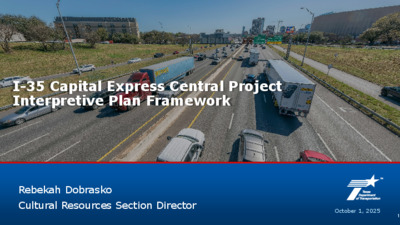03.0 - Briefing on the I-35 Interpretative Plan Presentation — original pdf
Backup

I-35 Capital Express Central Project Interpretive Plan Framework Rebekah Dobrasko Cultural Resources Section Director October 1, 2025 1 Project History & Context Location: 8-mile stretch of I-35 through central Austin (US 290 East to SH 71/Ben White Blvd) Purpose: Improve safety, reduce congestion, and enhance mobility for all users Improvements: Reconstructed cross-street bridges, new pedestrian/bicycle paths, and operational upgrades Historical Context: • I-35 built along East Avenue, a historic dividing line in Austin • Construction began in 1946; opened in 1962 • Shaped land use and reinforced social divides Current Phase: • Environmental clearance received (August 2023) • Final design and early construction underway Cultural Resource Mitigation: • Section 106 of the National Historic Preservation Act triggered • Interpretive Framework under development to acknowledge and share corridor history Connecting you with Texas. 2 Connecting you with Texas. What is an Interpretive Framework? • A planning tool that guides how stories about a place, project, or corridor are told • Supports inclusive, community-informed storytelling rooted in historical and cultural context • Provides a shared foundation for partner organizations to develop interpretive efforts 3 Connecting you with Texas. Purpose of the Interpretive Framework Mitigation Commitment: Developed as a cultural resource mitigation measure per the FEIS and Programmatic Agreement with the State Historic Preservation Office Geographic Focus: Covers I-35 corridor from Lady Bird Lake to Airport Boulevard Primary Goals: • Document and share the corridor’s historical and cultural narratives • Acknowledge impacts of past infrastructure decisions, especially on East Austin communities • Support community-informed storytelling Framework Components: • Unifying vision for interpretation • Summary of existing studies and efforts • Defined audiences for future content • Key themes shaped by community and agency input Intended Use: Serves as a guide for partner organizations to develop their own interpretive projects reflecting Austin’s cultural and natural history. 4 Connecting you with Texas. Working Group Development Purpose of the Working Group: • The Interpretive Framework is a mitigation-driven process that requires targeted, informed input—not general public feedback • The Working Group brings together key voices to ensure the Framework is accurate, meaningful, and historically grounded How Participants Were Identified: • Based on stakeholder relationships built during the Section 106 Review Process and • environmental compliance Includes representatives from consulting parties, community organizations, historical and cultural groups, and subject-matter experts in natural, social, and cultural topics 5 Connecting you with Texas. Importance of Stakeholder Involvement • Core to Framework Development: Local input ensures the Interpretive Framework reflects the unique history and experiences of the community. • Collaborative Process: Stakeholders help shape interpretive themes, identify key audiences, and guide storytelling priorities • Representation: Engagement with community leaders, historians, and subject- matter experts broadens the scope and depth of interpretation • Transparency & Trust: Regular working sessions promote openness, dialogue, and shared decision-making • Long-Term Value: A community-informed framework supports accurate, relevant, and lasting interpretive projects across the corridor 6 Composition of Working Group Connecting you with Texas. 7 Timeline PHASE 1: Planning and Foundation Building PHASE 2: Framework Development Phase 3: Finalization & Presentation 2025 Q2 – Q3 • Q2 2025: Collaborative Work 2025 - 2026 Q4 – Q1 2026 Q2 • Q1 2026: Collaborative Work • Q2 2026: Presentation Session #1 – Establish Session #3 – Develop to Working Group – Working Group Charter & Framework Outline & Synthesize Finalize and Present the Communication Norms Third-Party Resources • Q3 2025: Collaborative Work • Q1 - Q2 2026: Collaborative Session #2 – Finalize Charter, Work Session #4 – Review Draft Goals, and Objectives Framework & Gather Final Input Interpretive Plan Framework 8 Schedule for Upcoming Sessions Q3 2025 Q4 2025 Q1 2026 Q2 2026 Next Collaborative Work Session Upcoming Session Dates Q1 2026 Develop Framework Outline & Synthesize Third- Party Resources Q1 2026: Collaborative Work Session #3 Develop Framework Outline & Synthesize Third-Party Resources Q1 - Q2 2026: Collaborative Work Session #4 Review Draft Framework & Gather Final Input Q2 2026: Presentation to Working Group Finalize and Present the Interpretive Plan Framework 9 9 Contact Us i35capexcentral@hollawayenv.com Rebekah Dobrasko 512-431-3422 rebekah.dobrasko@txdot.gov